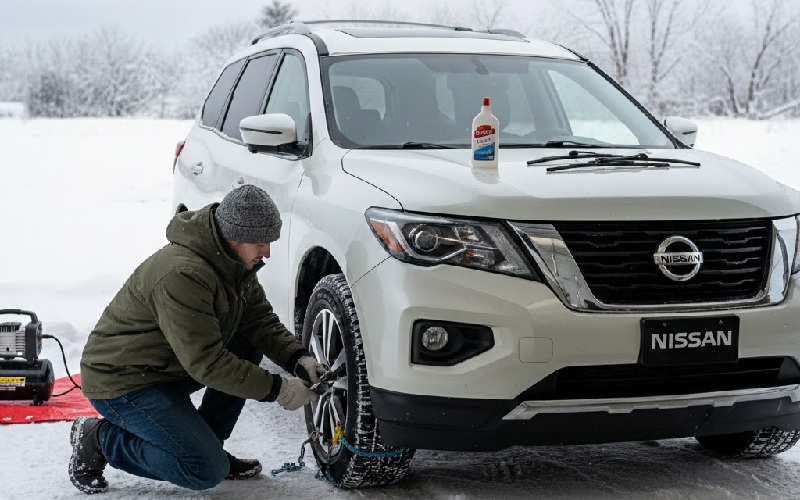Nissan Versa Engine Lights: Guide to Dashboard Indicators
The Nissan Versa, a popular compact car known for its reliability and efficiency, comes with a sophisticated onboard diagnostic system. This system uses various dashboard lights to communicate important information about the vehicle’s engine and other critical components. Understanding these lights is crucial for maintaining your Nissan Versa and ensuring its optimal performance. Check Engine […]
The Nissan Versa, a popular compact car known for its reliability and efficiency, comes with a sophisticated onboard diagnostic system. This system uses various dashboard lights to communicate important information about the vehicle’s engine and other critical components. Understanding these lights is crucial for maintaining your Nissan Versa and ensuring its optimal performance.

Check Engine Light (CEL)
The Check Engine Light, often depicted as an engine symbol or the text “CHECK ENGINE,” is one of the most critical indicators on your Nissan Versa dashboard.
What it means:
When illuminated, this light indicates that the vehicle’s onboard diagnostic system has detected an issue with the engine, emission control system, or related components.
Possible causes:
- Loose or faulty gas cap
- Malfunctioning oxygen sensor
- Failing catalytic converter
- Ignition system problems
- Mass airflow sensor issues
What to do:
If the light is steady, schedule a diagnostic check with a qualified mechanic soon. If it’s flashing, reduce speed and seek immediate professional assistance, which could indicate a severe problem that might damage the catalytic converter.
Oil Pressure Warning Light
This light typically appears as an oil can symbol or the text “OIL.”
What it means:
When lit, it indicates that the engine oil pressure is too low, which can lead to severe engine damage if not addressed promptly.
Possible causes:
- Low oil level
- Failing oil pump
- Clogged oil filter
- Worn engine bearings
What to do:
Pull over safely and turn off the engine immediately. Check the oil level and add oil if necessary. If the light remains on after adding oil, do not drive the vehicle and have it towed to a mechanic.
Battery Warning Light
This light usually appears as a battery symbol or the text “BATT.”
What it means:
When illuminated, it indicates an issue with the vehicle’s charging system.
Possible causes:
- Failing alternator
- Loose or corroded battery connections
- Worn drive belt
What to do:
If the light comes on while driving, turn off non-essential electrical components and drive to a safe location. Have the battery and alternator checked as soon as possible.
Temperature Warning Light
This light typically appears as a thermometer symbol or the text “TEMP.”
What it means:
When lit, it indicates that the engine is overheating, which can cause severe damage if not addressed quickly.
Possible causes:
- Low coolant level
- Failing water pump
- Stuck thermostat
- Radiator issues
What to do:
Pull over safely and turn off the engine. Allow it to cool down before checking the coolant level. Do not open the radiator cap when the engine is hot. If safe to do so, add coolant. If the problem persists, have the vehicle towed to a mechanic.
Brake System Warning Light
This light usually appears as an exclamation point within a circle or the text “BRAKE.”
What it means:
When illuminated, it could indicate a problem with the brake system or that the parking brake is engaged.
Possible causes:
- Low brake fluid
- Worn brake pads
- ABS system malfunction
- Engaged parking brake
What to do:
First, ensure the parking brake is fully released. If the light remains on, check the brake fluid level. If it’s low, add fluid and inspect the system for leaks. If the light stays on, have the brake system checked by a professional immediately.
Tire Pressure Monitoring System (TPMS) Light
This light typically appears as a tire cross-section with an exclamation point or the text “TPMS.”
What it means:
When lit, it indicates that one or more of your tires have low air pressure.
Possible causes:
- Underinflated tire(s)
- Sudden temperature drop
- Slow leak in a tire
What to do:
Check your tire pressure as soon as possible and inflate them to the recommended pressure (usually found on a sticker inside the driver’s door frame). If the light remains on after properly inflating the tires, have the TPMS system checked by a professional.
Traction Control System (TCS) Light
This light usually appears as a car with squiggly lines underneath or the text “TCS.”
What it means:
When flashing, it indicates that the traction control system is actively working to maintain grip. When constantly illuminated, it suggests a problem with the system.
Possible causes:
- Slippery road conditions (when flashing)
- Faulty wheel speed sensors
- TCS system malfunction
What to do:
If the light is flashing, drive cautiously, as road conditions may be slippery. If it stays on constantly, have the system checked by a professional.
Airbag Warning Light
This light typically appears as a person with a large circle in front or the text “SRS” (Supplemental Restraint System).
What it means:
When illuminated, it indicates a problem with the airbag system or seat belt pretensioners.
Possible causes:
- Faulty airbag sensors
- Issues with the airbag control module
- Problems with seat belt pretensioners
What to do:
Have the system checked by a qualified mechanic as soon as possible. A malfunctioning airbag system may not deploy properly in the event of an accident.
Low Fuel Warning Light
This light usually appears as a fuel pump symbol or the text “FUEL.”
What it means:
When lit, it indicates that the fuel level in the tank is low.
Possible causes:
- Low fuel level
- Faulty fuel level sensor
What to do:
Refuel your Nissan Versa as soon as possible. If the light remains on after refueling, have the fuel level sensor checked by a professional.
Malfunction Indicator Lamp (MIL)
This light is similar to the Check Engine Light but may appear as “SERVICE ENGINE SOON.”
What it means:
When illuminated, it indicates a problem with the vehicle’s emissions control system.
Possible causes:
- Faulty oxygen sensor
- Issues with the catalytic converter
- Problems with the EGR (Exhaust Gas Recirculation) system
What to do:
Have your vehicle diagnosed by a qualified mechanic. Driving with this light on could lead to increased emissions and reduced fuel efficiency.
Nissan Versa: Get To Know Dashboard Engine Lights
Understanding the various engine lights on your Nissan Versa dashboard is crucial for maintaining your vehicle’s health and ensuring your safety on the road. While some lights may indicate minor issues that can be addressed easily, others require immediate attention from a qualified mechanic. Regular maintenance and prompt attention to warning lights can help prevent more serious and costly repairs down the road.
Remember, this guide is meant to provide general information. Always consult your Nissan Versa owner’s manual for specific details about your vehicle’s warning lights and recommended actions. When in doubt, it’s always best to err on the side of caution and have your vehicle checked by a professional.
Questions and Answers about Nissan Versa Engine Lights
What should I do if multiple warning lights come on at once in my Nissan Versa?
If multiple warning lights illuminate simultaneously, it’s best to pull over safely and turn off the engine. This could indicate a serious problem, and continuing to drive might cause further damage. Call for roadside assistance or a tow truck to inspect your vehicle by a professional.
How soon should I address a Check Engine Light on my Nissan Versa?
If the Check Engine Light is steady, you should have your vehicle checked within a few days. If it’s flashing, reduce speed and have the vehicle inspected immediately, as this could indicate a severe problem that might damage the catalytic converter.
Can I still drive my Nissan Versa if the Oil Pressure Warning Light comes on?
No, you should not drive your vehicle if the Oil Pressure Warning Light is on. Pull over safely, turn off the engine, and check the oil level. If it’s low, add oil. If the light remains on after adding oil, have the vehicle towed to a mechanic to prevent engine damage.
What’s the difference between the Check Engine Light and the Malfunction Indicator Lamp in a Nissan Versa?
While both lights can indicate engine issues, the Malfunction Indicator Lamp (MIL) specifically relates to the emissions control system. The Check Engine Light can indicate a broader range of engine and system issues.
How often should I check my Nissan Versa tire pressure to avoid the TPMS light coming on?
It’s a good practice to check your tire pressure at least once a month and before long trips. This can help prevent the TPMS light from coming on unexpectedly and ensure optimal tire performance and fuel efficiency.
Can cold weather cause warning lights to come on in my Nissan Versa?
Yes, cold weather can sometimes cause warning lights to illuminate, particularly the TPMS light. This is because tire pressure decreases in cold temperatures. The Battery Warning Light might also come on if the battery is weak and struggling in cold conditions.
If my Nissan Versa Battery Warning Light comes on while driving, how long can I continue driving?
If the Battery Warning Light comes on while driving, try to minimize the use of electrical accessories and drive to a safe location as soon as possible. The car may continue running for a short while on battery power alone, but it’s best to address the issue promptly to avoid being stranded.
What should I do if the Temperature Warning Light comes on in my Nissan Versa?
If the Temperature Warning Light illuminates, safely pull over and turn off the engine immediately. Allow the engine to cool before checking the coolant level. Do not open the radiator cap when the engine is hot. If safe, add coolant. If the problem persists, have the vehicle towed to avoid engine damage.
Can I reset the Check Engine Light in my Nissan Versa myself?
While it’s possible to reset the Check Engine Light by disconnecting the battery, this is not recommended. The light will likely come back on if you don’t address the underlying issues. It’s best to have a professional diagnose, fix, and reset the light.
How serious is it if the Airbag Warning Light stays on in my Nissan Versa?
An illuminated Airbag Warning Light is a serious concern. It indicates that there may be a problem with your vehicle’s airbag system or seat belt pretensioners. This could mean that these crucial safety systems may not function properly in the event of an accident. Have the system checked by a qualified mechanic as soon as possible.


